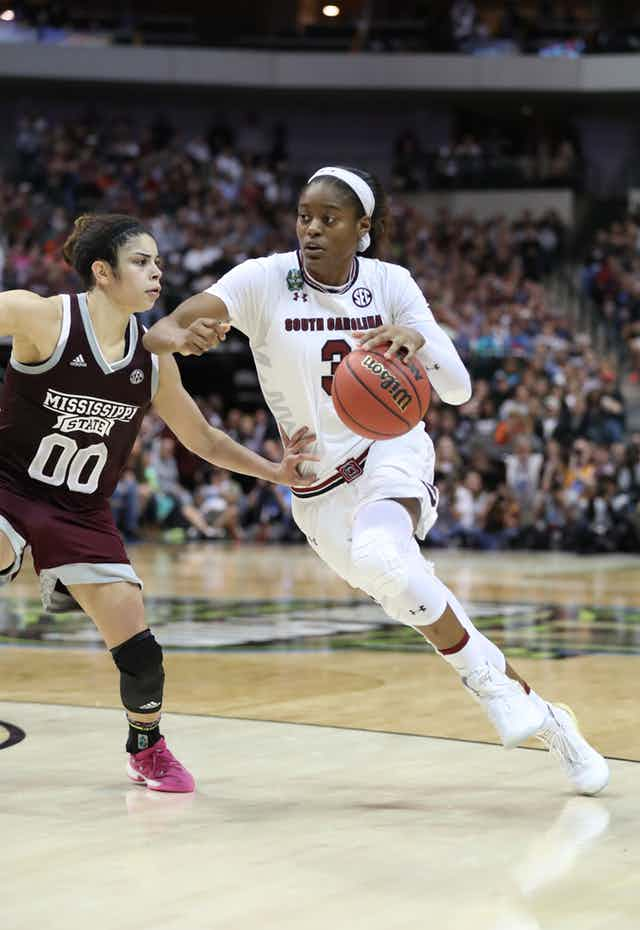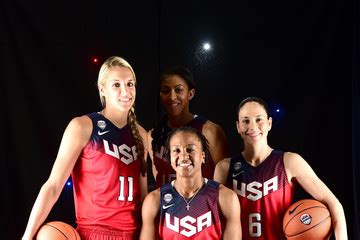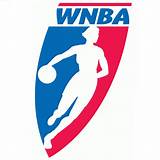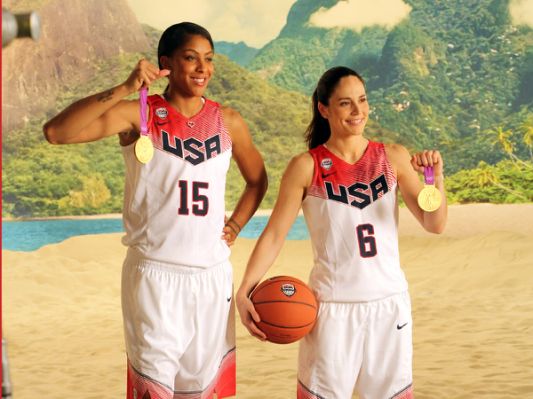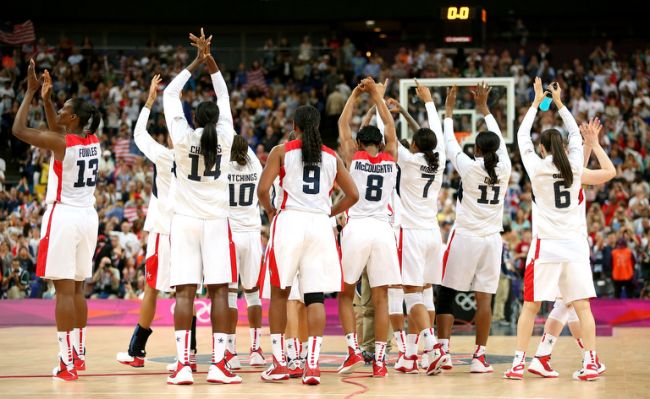By Nicole Manning
Now, can anyone name me a famous basketball player? And another? And another one? When I asked you to name a basketball player, your mind automatically went to a man. Why? It’s simple really. For years, society has encouraged us to consider women and girls second in social value, and we haven’t even realized it.
Basketball was created by a man named Dr. James Naismith, who made peach baskets into hoops, that could accommodate a soccer ball, to help young athletes have fun and stay fit. This evolved into the popular game called “basketball,” that many people today love and put their blood, sweat, and tears into—both literally and figuratively. Although Dr. Naismith may not have imagined women investing as much grit and determination into this game as men, female players are now among the world’s best. Many women (like Candice Parker, who won an MVP award in 2013, and Sue Bird, who has won the gold medal at the Summer Olympics every four years since 2004), continue to make a difference in how female players are viewed.
When one looks at Stanford’s stats on their Women and Men’s basketball teams, it states that for women, “Total Scoring: 2420, Points Per Game:73.3, and Scoring Margin 13.1” (Stanford). But for the men it reads, “Total Scoring: 2172, Points Per Game:70.1, and Scoring Margin:7.6” (Standford). These facts are justification for believing that there are women in basketball who devote just as much love and passion to the game as men. So why are WNBA players forced to accept a lower pay scale than their peers in the NBA? Why are strong, determined female players not being equally rewarded for their obvious skill and devotion?
 When it comes to the WNBA, women have proven they have just as much love for the game of basketball as anyone. Yet society has created a culture that continues to put them second. Women today are doctors, scientists, teachers, lawyers, and musicians who have been successful at changing the demographics of their field, but are still being paid less than their male colleagues. Women in sports are often downgraded when it comes to public recognition. Sadly, the WNBA is yet another profession in which females get treated as if they Are somehow not worth as much as men.
When it comes to the WNBA, women have proven they have just as much love for the game of basketball as anyone. Yet society has created a culture that continues to put them second. Women today are doctors, scientists, teachers, lawyers, and musicians who have been successful at changing the demographics of their field, but are still being paid less than their male colleagues. Women in sports are often downgraded when it comes to public recognition. Sadly, the WNBA is yet another profession in which females get treated as if they Are somehow not worth as much as men.
In a Time magazine article, basketball player Enes Kanter states, “Before the CBA, female athletes received less than 30% of revenue-sharing and lost half of their salaries if they went on maternity leave during the season. During the off-seasons, many players went overseas … where the pay is six to 12 times more than WNBA salaries,” Kantner continued. ”[W]omen are leaving […] their country […] their families, working twice as hard and still getting paid less than male players do”. In addition to competing on the court, these women are also mothers, wives, and friends who want to support themselves and their loved ones with their passion for a game they love and the profession that they have chosen. All they want is equal pay for equal work.
* * *
What if you found out that MCSM’s Ms. Rubin was getting paid less than a male teacher for the same job? She went to college, completed the same courses and training, and continues to work hard and be the great teacher she is today. So, if she were being paid less and given less respect than a male teacher just because of her gender, this would be unfair.
Don’t get me wrong, I’m not saying that the NBA or men, in general, don’t have their own pay scale struggles. But, women experience other day-to-day problems that make it harder for women to achieve equality, especially in basketball.
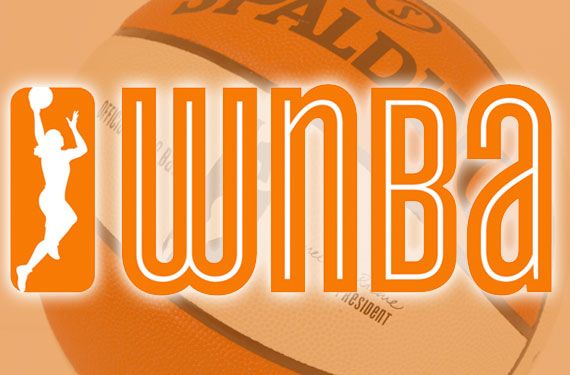 Perhaps the biggest obstacle is the perception that women should only occupy specific roles in society. There is an old-fashioned idea that young girls like you and I shouldn’t push to have leadership positions, or truly `know our worth.’ It’s a cultural fear that women can actually be something and make a difference in the world besides being mothers and wives. Believe me, it’s become clear over time why women in Pro-Basketball are not being paid the same as male players.
Perhaps the biggest obstacle is the perception that women should only occupy specific roles in society. There is an old-fashioned idea that young girls like you and I shouldn’t push to have leadership positions, or truly `know our worth.’ It’s a cultural fear that women can actually be something and make a difference in the world besides being mothers and wives. Believe me, it’s become clear over time why women in Pro-Basketball are not being paid the same as male players.
One straightforward reason people give for unequal treatment is that the women’s games are not selling-out, or receiving the same recognition and acknowledgment as NBA games do. However, many believe this is only because the NBA almost ignores the WNBA, and doesn’t promote their games the same as they would if the athletes were men.
It’s important to remember that ever since the start of the WNBA in 1996, women in basketball have been fighting on and off the court to be promoted just as aggressively as men. In a New York Times article, one passionate writer named Sandomir stated: “We need to promote these women! [The] WNBA’s modest attendance and television viewership […] illuminate a stubborn imbalance between men’s and women’s professional leagues—adding to the expanding debate about the place of women’s sports [which is ] still struggling to develop and hold lasting public interest.
“Some professional women’s […] events do generate a broad following,” Sandomir continued, “but those tend to be exceptions. There has yet to be a financially viable women’s mainstream sports league in the United States.”
I believe that all that should be necessary to validate an athelete’s existence (regardless of gender), is a dedication to their profession that yields success for their teams. When we see women today who are top models and actresses, we see them being fully supported and sponsored in their careers by being featured in commercials, on billboards, and other promotional outlets. Although a few individual female athletes become household names, like Serena Williams or Lindsey Vonn, it is rare to see the same sort of name recognition and sponsor promotion for women in the WNBA.
 Indeed, if you don’t watch sports channels in-depth, you honestly would barely know about women’s basketball at the professional or college level, which showcase many talented female players. I remember my mom and I once had a conversation about the WNBA. Honestly, I couldn’t think of any other “name” basketball players besides Candice Parker and Sue Bird, just because I had seen them hosting NBA events that I watched with my dad.
Indeed, if you don’t watch sports channels in-depth, you honestly would barely know about women’s basketball at the professional or college level, which showcase many talented female players. I remember my mom and I once had a conversation about the WNBA. Honestly, I couldn’t think of any other “name” basketball players besides Candice Parker and Sue Bird, just because I had seen them hosting NBA events that I watched with my dad.
Lord knows it takes me a couple of tries on the court to make a basket, but it still makes me confused how every day we can see featured NBA players on TV doing big things, but rarely do we see the female basketball players who look like me and who could inspire me.
Another reason for the lack of visibility for the WNBA might be because their season is during the summer when people are mostly outside and enjoying time away from the TV. The league simply doesn’t do enough to push women basketball players and generate the fans and support they need, even though they have the resources to do it. While my perspective is shared by many others around me, most of them remain loyal to their NBA roots, and choose to believe in the “support” the NBA supposedly gives the female teams.
Many fans who stay on top of basketball, believe that because the NBA has been around longer, it’s naturally going to be more successful without even trying to downgrade the WNBA on purpose. In another New York Times article, a reporter observes: “Comparisons between the two are inevitable and yet often misleading: The NBA is more successful but also 50 years older, which has allowed it to mold the game — and the audience — in its image.” I maintain however, that even though the NBA was formed in 1946 and the WNBA in 1996, this shouldn’t mean that the women of the WNBA deserve less pay and consideration.
Just look at other professions such as teaching. In the field of education there is longevity regardless of gender. Although women may have been teachers longer than men, they are still getting paid along the same lines. So why when it comes to women in sports, (specifically women in basketball), aren’t players given the same respect, representation, and treatment regardless of gender?
A few NBA players have really made an effort to stand up for the rights of women in basketball. Players like Kobe Bryant, who was fighting for fair treatment of women in basketball with his daughter Gianna before they died, really made a difference, and brought many issues to light. Even though the NBA has created a loyal fanbase through its decades of games, I feel it now has a social obligation to convince those fans to similarly value the female stars of the WNBA.
To conclude, women need to stop being put second, when it comes to the game of basketball. Through researching my argument, I learned more about not just basketball, but also about how much women have brought to the game. Since March is women’s history month, This is the perfect time to realize how much women can do besides being wives and mothers. It also highlights the continuing trends that delay women’s progress in many professions.
No matter who you are, if you have a passion for being something, but saw everyone who looked like you being undervalued in that career, you would feel yourself being downgraded too.
The young women’s rights activist Malala Yousafzai once said, “I raise up my voice—not so that I can shout, but so that those without a voice can be heard…. We cannot all succeed when half of us are held back.” Basketball is a game about teamwork, love, and mutual support. Those same qualities should also shape how the professional culture of basketball treats its female players in the future.
